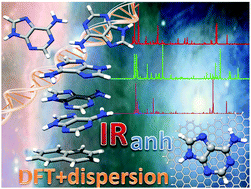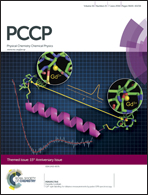Dispersion corrected DFT approaches for anharmonic vibrational frequency calculations: nucleobases and their dimers†
Abstract
Computational spectroscopy techniques have become in the last few years an effective means to analyze and assign infrared (IR) spectra of molecular systems of increasing dimensions and in different environments. However, transition from compilation of harmonic data to fully anharmonic simulations of spectra is still underway. The most promising results for large systems have been obtained, in our opinion, by perturbative vibrational approaches based on potential energy surfaces computed by hybrid (especially B3LYP) density functionals and medium size (e.g. SNSD) basis sets. In this framework, we are actively developing a comprehensive and robust computational protocol aimed at quantitative reproduction of the spectra of nucleic acid base complexes and their adsorption on solid supports (organic/inorganic). In this contribution we report the essential results of the first step devoted to isolated monomers and dimers. It is well known that in order to model the vibrational spectra of weakly bound molecular complexes dispersion interactions should be taken into proper account. In this work we have chosen two popular and inexpensive approaches to model dispersion interactions, namely the semi-empirical dispersion correction (D3) and pseudopotential based (DCP) methodologies both in conjunction with the B3LYP functional. These have been used for simulating fully anharmonic IR spectra of nucleobases and their dimers through generalized second order vibrational perturbation theory (GVPT2). We have studied, in particular, isolated adenine, hypoxanthine, uracil, thymine and cytosine, the hydrogen-bonded and stacked adenine and uracil dimers, and the stacked adenine–naphthalene heterodimer. Anharmonic frequencies are compared with standard B3LYP results and experimental findings, while the computed interaction energies and structures of complexes are compared to the best available theoretical estimates.

- This article is part of the themed collection: PCCP’s 15th anniversary

 Please wait while we load your content...
Please wait while we load your content...